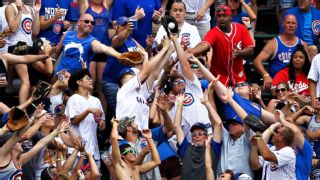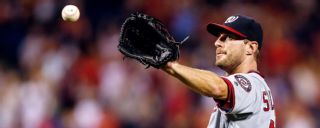|
The day before the All-Star Game, Max Scherzer was in a good mood. He talked about University of Missouri football, how the curveball he developed in 2013 took his game to the next level and the new cutter he's starting to throw. Then he was asked about the home run spike across the majors. "I'm not going to throw that stone and make accusations," he said with his agitation showing. "But it would be interesting to see what Major League Baseball says. Do they have any opinions or thoughts or reasons? You don't see year-to-year jumps like this. Usually, everything stays within itself unless something drastic happens, like moving the fences in around the league, and that didn't happen." About the ball ... "Even if they did make a change," Scherzer said, "I wouldn't be able to feel anything different." With a National League-leading 21 home runs allowed, maybe Scherzer is simply a little sensitive to the topic of home runs. But he isn't the only pitcher serving them up. Entering Monday's games, MLB was on pace for 5,584 home runs. That would be 675 more than in 2015, a 13.8 percent increase, and a staggering 1,398 more than in 2014, an increase of more than 33 percent. The only season with a higher rate of home runs hit was 2000, in the heart of the steroid era. Players live in a sort of baseball bubble, hyper-focused on the day-to-day and often unaware of the bigger trends, but the rise in home runs is a hot topic in many clubhouses. "One conspiracy theory is that the cork is different," Orioles closer Zach Britton said. "The balls are flying, so as players, we're like, 'There are two things that fans really like: strikeouts and home runs.' You're getting a lot of that this year. Some players -- not just on our team, we were talking to other players in general -- we wondered if the cork was different. I know MLB wanted to get more offense in the game, so you can do that without changing a strike zone or something in general? You can somehow change the cork maybe." Blue Jays starter Marco Estrada has talked about this with teammate R.A. Dickey. "I don't know if it's true or not, but he thinks they're winding the balls a little tighter this year," Estrada said. "It kind of makes sense, because it feels like guys are hitting home runs left and right this year." Astros pitchers were aware early on, reliever Will Harris said. "I know in April, it was ridiculous the amount of home runs that were being hit," he said. "You saw the big innings, a lot of six-, seven-run innings and guys hitting the balls out of ballparks, so I don't know what's up. Scouting reports, advanced scouting, all that kind of stuff, I don't know. Global warming? Maybe it's a little hotter in these ballparks." Maybe the balls are slicker this year, Britton said: "They definitely don't rub them down as much. That's been an issue we talk about all the time as pitchers. It's so hard to grip baseballs."  None of the other players we talked to, however, noticed anything different with the balls. Brewers catcher Jonathan Lucroy was adamant that they're the same. "We would be able to tell," he said. "I've been playing big league ball for six years. If there was something different, I could feel it." Commissioner Rob Manfred echoed that during his All-Star break news conference. He's confident, he said, that the rise in home runs isn't related to steroids or juiced baseballs. "We think it has to do with the way pitchers pitch and the way hitters are being taught to play the game," Manfred said. "You've seen some unusual developments, in terms of home run hitters being up in the lineup to get them more at-bats. So we think it has more to do with the game this time around, because we're comfortable we're doing everything we can on the performance-enhancing drugs front." As Manfred noted, former Nippon Professional Baseball commissioner Ryozo Kato was forced to resign in 2013 amid a scandal over livelier baseballs in Japan. There are substantial risks that would make it unwise for MLB to take part in any kind of orchestrated effort to change the balls. Rawlings Sporting Goods produces MLB balls at a factory in Costa Rica, and a baseball spokesman said "extensive reviews" have shown no change in the ball that might have contributed to rising home run totals over the past year. Still, something seems to be going on, and in fact, this surge goes to last season, when home runs on contact suddenly soared in August and September. (Rob Arthur and Ben Lindbergh did a great job examining this on fivethirtyeight.com back in March.) One factor would seem to be what Manfred alluded to: that the game is emphasizing the long ball more than ever, with the Ben Revere-type slap hitters being slowly phased out of regular playing time. Indeed, the percentage of fly balls, according to data from ESPN Stats & Info, has gone up the past two seasons: 2014: 29.8 percent
2015: 30.2 percent
2016: 31.0 percent The road block here, however, is that our data says the fly ball rate in 2013 was 34.4 percent, and in 2012 it was 34.5 percent. That could be an issue of how some balls are categorized. The average distance on home runs has increased from 397 feet in 2014 to 401.7 feet in 2016. Of course, those are just estimates, but even a few extra feet on the average distances of fly balls can translate to a lot of home runs. Are those few extra feet coming from the players or the balls? A common theory among players is that power pitching translates to more power.  "I think it goes back to this," AL MVP Josh Donaldson said. "The average fastball six [or] seven years ago was probably 91 mph, somewhere around there. I think the average fastball nowadays is around 93. When you're talking formulas and mathematic equations, when you get a higher velocity and you're able to square up a ball that's a little bit firmer, the ball is going to travel further. That's science." As Lucroy put it, "The old saying is, 'The harder you throw, the farther it goes.' I think it's true in this case. Strikeout numbers are up too. It's all related." Except science suggests that pitcher velocity has little to do with home run distance. Take the Home Run Derby as an example: Batters are crushing 70 mph fastballs. Dr. Alan Nathan, professor emeritus of physics at the University of Illinois, has written that each mph of pitch speed adds about 0.2 feet to the distance of a batted ball. In that case, the difference between connecting squarely with 91 mph fastballs and connecting with 95 mph balls is about 0.8 feet, which explains only a small part of the increase in fly ball and home run distances. That means home runs are coming primarily from exit velocity generated by the hitter, which comes largely from bat speed, and that leads to another theory: The new wave of young sluggers, such as Kris Bryant and Corey Seager, is largely responsible for the uptick. Joe Sheehan wrote about the home run spike Monday and studied the impact of young hitters by tracking the home run rates for the debut classes of 2014, 2015 and 2016. They're hitting for more power -- the 2014 class had a 2.1 percent HR/PA rate that year and is at 3.1 percent in 2016, while the 2016 class has a 3.3 percent rate -- but as Joe wrote, "It's hard to suss out whether they're driving the overall rates or simply riding the wave. ... Remember that the league HR/PA rate is over 4 percent right now. These classes are lowering that figure, not raising it." Stephen Vogt suggested pitchers are throwing too many bad cutters up in the strike zone. Eric Hosmer said the pitching is better than ever, so it must be all the amazing young hitters. Cole Hamels said it's about a change in hitting approach. "Guys throw harder, and I think the hitters are taking a different approach," he said. "The video out there is so in-depth. The analytics are off the charts. Guys are guessing more now, and they've been able to hone their style of hitting so much, it's affecting everybody." That certainly makes sense: an all-or-nothing approach that leads to more home runs and more strikeouts. As Donaldson added, "I think it's taken hitters a little time to adjust to the velocity you're seeing night in and night out." Batters are hitting .250/.323/.384 against pitches of 95-plus compared with .235/.307/.336 in 2014. In 2014, they hit 193 home runs against pitches of 95-plus. In 2016, they have already hit 219, which puts them on pace for 402. Of course, that could be a symptom, not a cause, if you believe in Britton's cork conspiracy. It's important to note that 2016 is extreme on one end, and 2014 was extreme on the other. The two-year increase appears particularly dramatic because there were 4,934 home runs in 2012 and 4,661 in 2013 before a drop to 4,186 in 2014. Although 675 is a lot more home runs from one season to the next, it represents only 22.5 additional home runs per team or about four per month or one extra home run per team each week. That doesn't sound like much, does it? Tell that to Max Scherzer.
|


